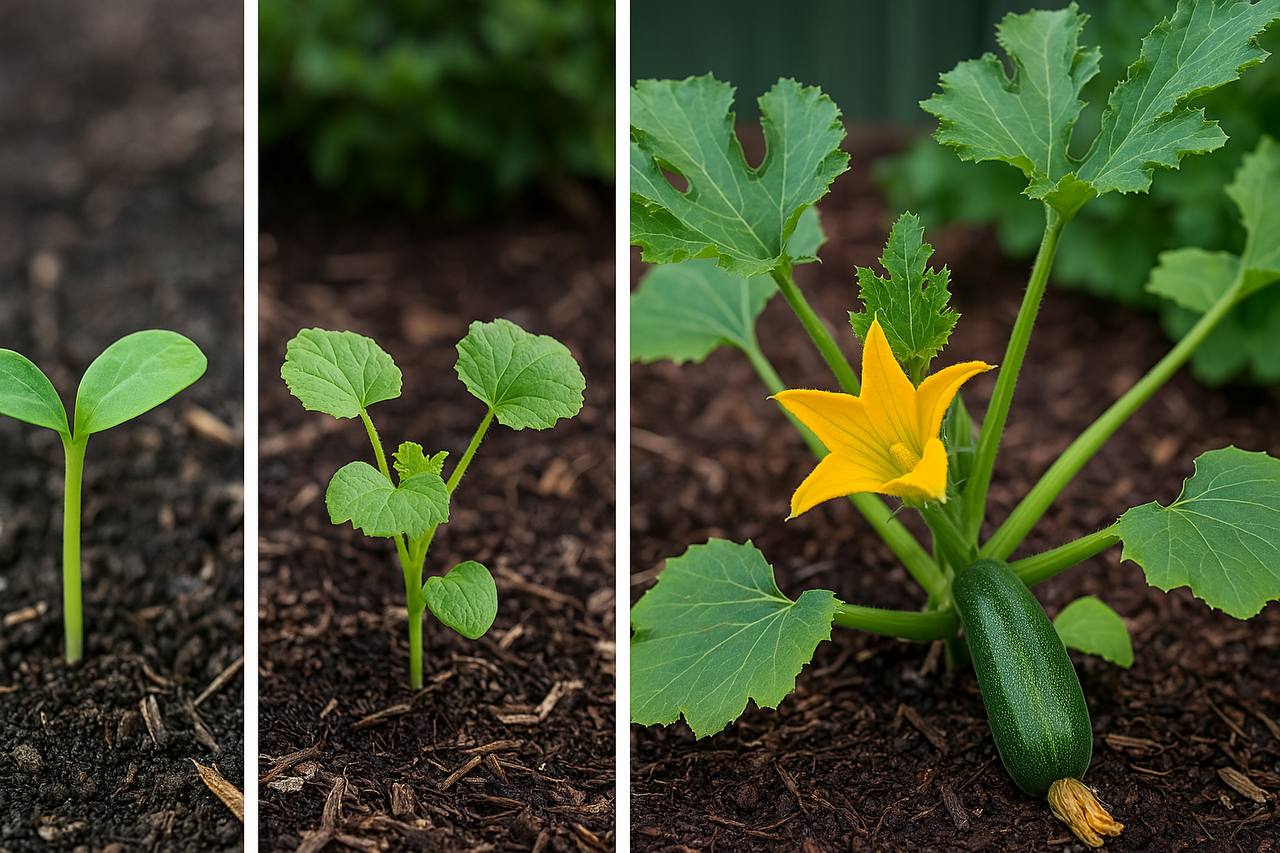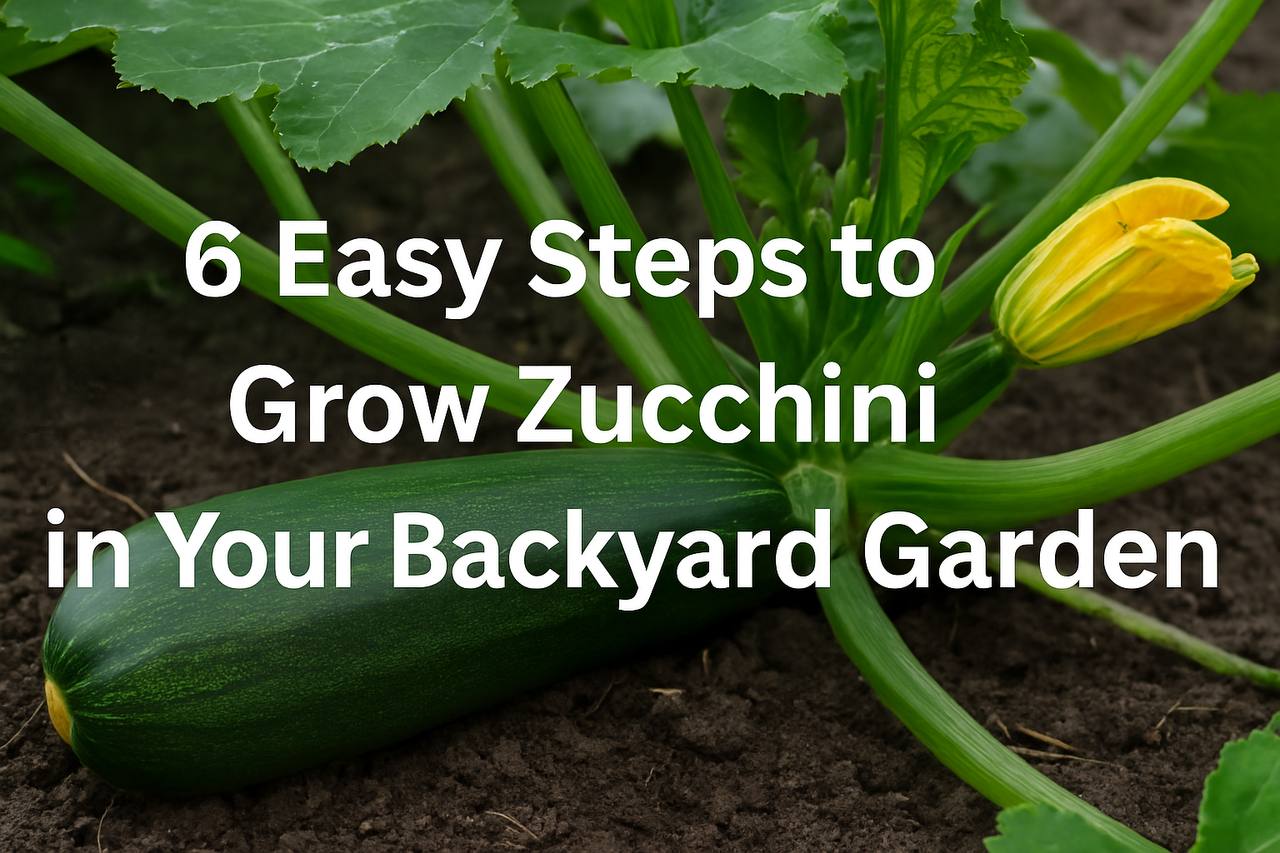Zucchini is one of the most satisfying vegetables to grow for American gardeners—especially beginners. With fast germination, rapid growth, and an abundant harvest, it’s a summer squash that rewards you with very little hassle. Whether you’re in USDA Zone 5 or Zone 10, you can grow zucchini successfully with just a few basic techniques.
In this guide, you’ll discover 6 Easy Steps to Grow Zucchini in Your Backyard Garden—including tips for soil prep, watering, pest prevention, and maximizing your yield.
⸻
Contents
- 1 1. Choose the Right Time and Place
- 2 2. Prepare Nutrient-Rich Soil
- 3 3. Plant Seeds or Transplants Correctly
- 4 4. Water Deeply and Regularly
- 5 5. Feed the Plants
- 6 6. Harvest and Enjoy Your Zucchini
- 7 Troubleshooting Common Issues
- 7.1 Final Thoughts: Zucchini Is a Summer Superstar
- 7.2 FAQ
- 7.3 When is the best time to plant zucchini?
- 7.4 How much sunlight do zucchini plants need?
- 7.5 What type of soil works best for growing zucchini?
- 7.6 How should I water my zucchini plants?
- 7.7 How far apart should zucchini plants be spaced?
- 7.8 When should I harvest zucchini?
- 7.9 What can I do to encourage more zucchini production?
1. Choose the Right Time and Place
Timing is everything with zucchini. It’s a warm-season crop that cannot tolerate frost. In most U.S. states, this means planting zucchini from late April through early June, depending on your local last frost date.
Location Matters:
Zucchini thrives in full sun, so pick a garden bed or container that gets at least 6–8 hours of direct sunlight daily. If your summers are hot (like in the South or Southwest), providing light afternoon shade can protect plants from heat stress.
⸻
2. Prepare Nutrient-Rich Soil
Healthy soil = healthy zucchini. Loamy, well-draining soil rich in organic matter will help your plants establish quickly and produce fruit longer.
Soil Tips:
• Add compost or aged manure 1–2 weeks before planting.
• Maintain a soil pH of 6.0 to 7.5.
• Avoid heavy clay or compacted soils; these retain too much water and can cause root rot.
Raised Beds or Containers? Zucchini also grows well in large containers (at least 18–24 inches wide and deep), making it perfect for patios or small spaces.

⸻
3. Plant Seeds or Transplants Correctly
Zucchini can be direct-seeded into the garden or started indoors and transplanted. Seeds sprout quickly—often in 5–7 days.
Planting Guide:
• Sow seeds 1 inch deep, in groups of 2–3.
• Space hills or seedlings 2–3 feet apart to allow for airflow and prevent mildew.
• For containers, use compact or bush varieties like ‘Raven’ or ‘Eight Ball’.
Once your seedlings are a few inches tall, thin out the weakest ones, leaving just one strong plant per mound or container.
⸻
4. Water Deeply and Regularly
Consistent moisture is the key to strong growth and fruit development. Zucchini plants need about 1 inch of water per week, but may require more in hot or dry climates.
Watering Tips:
• Water in the morning to prevent fungal issues.
• Focus water at the base to avoid wetting leaves.
• Use mulch (like straw or wood chips) around plants to reduce evaporation and suppress weeds.
In containers, check moisture daily—potted zucchini tends to dry out faster than in-ground plants.
⸻
5. Feed the Plants
Zucchini is a heavy feeder—it needs steady nutrients to fuel rapid growth. If your soil isn’t nutrient-rich to begin with, supplement with an organic vegetable fertilizer.
Feeding Guide:
• Use a balanced or low-nitrogen fertilizer (5-10-10 or similar).
• Apply once after the first true leaves emerge, and again every 3–4 weeks.
• For an organic boost, add compost tea, worm castings, or seaweed extract.
Avoid too much nitrogen, which produces lush leaves but fewer fruits.

⸻
6. Harvest and Enjoy Your Zucchini
Zucchini can grow overnight—literally! Check your plants daily once they start producing.
When to Harvest:
• Best size: 6–8 inches long, while the skin is still tender.
• Use a knife or garden scissors to cut fruits cleanly at the stem.
• Don’t let zucchini overgrow—large fruits reduce production and become seedy.
Bonus Tip: Harvesting often encourages more blooms and extends your harvest window.
⸻
Troubleshooting Common Issues
• Powdery Mildew: Improve airflow by spacing plants out and watering at the base.
• Squash Vine Borers: Cover plant stems with soil and use row covers early in the season.
• Blossom End Rot: Maintain even watering and ensure calcium levels are adequate.
Learn more about 7 simple steps to grow dragon fruit indoors
⸻
Final Thoughts: Zucchini Is a Summer Superstar
Growing your own zucchini is not only satisfying but also surprisingly simple. With the right timing, care, and a sunny backyard, you can enjoy a bountiful harvest of this nutritious and versatile vegetable. Whether you’re a beginner or a seasoned gardener, following these 6 Easy Steps to Grow Zucchini in Your Backyard Garden will set you up for success—and fresh homegrown zucchini all season long!
Whether you’re gardening in Texas, Oregon, or anywhere in between, these steps will help you grow more confidently and harvest like a pro.
FAQ
When is the best time to plant zucchini?
Plant zucchini outdoors after the last frost when soil temperatures reach at least 60°F (16°C).
How much sunlight do zucchini plants need?
Zucchini requires at least 6–8 hours of direct sunlight daily.
What type of soil works best for growing zucchini?
Use loose, well-draining soil enriched with compost or aged manure with a pH between 6.0 and 7.5.
How should I water my zucchini plants?
Water deeply when the top inch of soil is dry, providing about 1 inch of water per week, and use mulch to retain moisture.
How far apart should zucchini plants be spaced?
Space zucchini plants 2–3 feet apart to allow adequate airflow and room for vine growth.
When should I harvest zucchini?
Harvest zucchini when they are 6–8 inches long to ensure the best flavor and texture.
What can I do to encourage more zucchini production?
Regular harvesting stimulates new growth, and proper fertilization every 3–4 weeks will boost production.
A garden is a place that relaxes us and reflects our personal style, it’s a place to spend time with loved ones and grow our own fruits and vegetables. Maybe you’re looking for design inspiration or plant selection, or you’re concerned about garden privacy, shady areas, or pests, but don’t worry, you’ve come to the right place.
